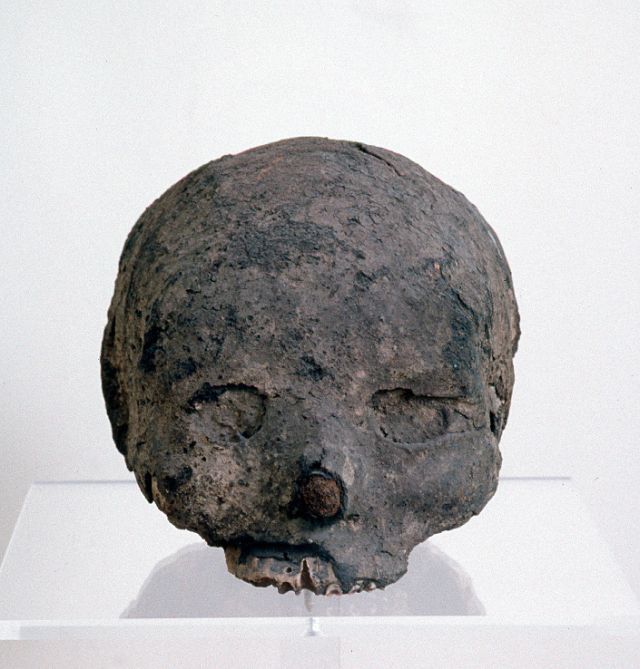 Mumia; Head of a Mummy, used for wound healing and plasters until the end of the 18th century.
Mumia; Head of a Mummy, used for wound healing and plasters until the end of the 18th century.
In order to restore youth to an aging body, the fifteenth-century practitioner, Marsilio Ficino, advised:
There is a common and ancient opinion that certain prophetic women who are popularly called ‘screech-owls’ suck the blood of infants as a means, insofar as they can, of growing young again. Why shouldn’t our old people, namely those who have no [other] recourse, likewise suck the blood of a youth? — a youth, I say who is willing, healthy, happy and temperate, whose blood is of the best but perhaps too abundant. They will suck, therefore, like leeches, an ounce or two from a scarcely- opened vein of the left arm; they will immediately take an equal amount of sugar and wine; they will do this when hungry and thirsty and when the moon is waxing. If they have difficulty digesting raw blood, let it first be cooked together with sugar; or let it be mixed with sugar and moderately distilled over hot water and then drunk. [1]
At first glance, cannibalistic medical practices such as this seem far removed from our own culture. However, the utilisation of body parts for medicinal purposes still persists today, albeit in different forms. Although blood transfusions or organ transplantation may seem dramatically different than drinking the blood or eating the flesh of another human being, these medical practices do share a common belief in the body as an instrument of healing.
Blood, in particular, featured prominently in the treatment of the sick during the early modern period as it was central to the Galenic model of health which was dependent on a balance of the body’s four humours (blood, phlegm, black bile and yellow bile). The image of a patient being bled—his sleeve rolled up, blood pouring from an opened vein into a bowl placed below his elbow—is one which is familiar to us. Less familiar, however, is the image of epileptic patients crowded around the scaffold, cups in hand, waiting to ‘quaff the red blood as it flows from the still quavering body’ of a freshly executed criminal. [2] Thus, blood could be both contaminating in its excess and restorative in its replenishment.
The surgeon’s association with blood contributed to the duality of his image during the early modern period. Like blood, he had both the power to heal and the power to harm. [3] Not only would the surgeon come into contact with blood through surgical procedures, but he might also taste a person’s blood in order to test its consistency when attempting to diagnosis his patient.
Medicinal cannibalism existed in other forms as well. One of the most common human substances used by apothecaries during the early modern period was mummy, a ‘medicinal preparation of the remains of an embalmed, dried, or otherwise “prepared” body that had ideally met with sudden, preferably violent death’. [4] Sometimes referred to as ‘the menstruation of the dead’, this remedy was recommended to patients as late as 1747. In The Marrow of Physick (1669), Thomas Brugis wrote:
A Mans Skull that hath been dead but one yeare, bury it in the Ashes behinde the fire, and let it burne untill it be very white, and easie to be broken with your finger; then take off all the uppermost part of the Head to the top of the Crowne, and beat it as small as is possible; then grate a Nutmeg, and put to it, and the blood of a Dog dryed, and powdered; mingle them all together, and give the sick to drinke, first and last, both when he is sick, and also when he is well, the quantity of halfe a Dram at a time in white Wine. [5]
Although the sixteenth-century surgeon, Ambrose Paré, noted that mummy (or mumia as it was sometimes known) was ‘the very first and last medicine of almost all our practitioners’ against bruising, the substance did not come cheap. In 1678, a pound of mummy could cost as much as 5s 4d. [6] Thus, many apothecaries substituted mummy with cheap imitations that typically came from the corpses of beggars, lepers and plague victims.
As popular as ‘corpse medicine’ was during the early modern period, this does not mean it was not without its critics, many of whom described these remedies as cannibalistic and unnatural. By the late eighteenth century, practitioners had stopped prescribing ‘three drams of [crushed] human skull’ for epilepsy, or ‘two ounces of mummy in a plaster against ruptures’. [7] However, the concept of the body as an instrument of healing continued to persist, and indeed, still exists today albeit in a much more dehumanised (mechanised) form.
1. Marsilio Ficino, De Vita II (1489), 11: 196-199. Translated by Sergius Kodera.
2. Mabel Peacock, ‘Executed Criminals and Folk Medicine’, Folklore 7 (1896), p. 274.
3. P. Kenneth Himmelmann, ‘The Medicinal Body: An Analysis of Medicinal Cannibalism in Europe, 1300-1700’, Anthropology 22 (1997), pp. 192.
4. Karen Gordon-Grube, ‘Anthropophagy in Post-Renaissance Europe: The Traiditon of Medicinal Cannibalism’, American Anthropologist, 90 (1988), p. 406.
5. Thomas Brugis, The Marrow of Physick (London, 1669), p. 65.
6. Richard Sugg, ‘“Good Physic but Bad Food”: Early Modern Attitudes to Medicinal Cannibalism and its Suppliers’, Social History of Medicine, 19:2 (2006), p. 227.
7. J. Quincy (ed.), The Dispensatory of the Royal College of Physicians (London, 1721), pp. 86, 221.
